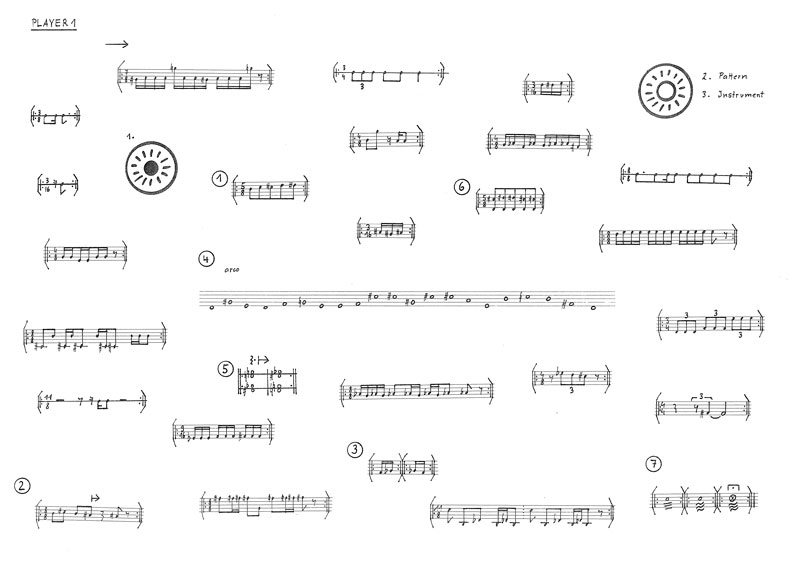Ordinary music Vol. 13, for percussion sextet (2009)The piece belongs to the genre of mobiles, a form developed by Roman Haubenstock Ramati and Earle Brown around the same time, in the late 1950s (later taken up by Karlheinz Stockhausen, among others), in which pre-composed structural elements are intuitively assembled by the performer, creating a moment of unpredictability.While composing the piece, I practiced Terry Riley's In C on the xylophone. From this dynamic, I developed my own rhythmic patterns; however, unlike Riley, I dispensed with both tonality and chronology. The patterns in this piece are each arranged at intervals of one, two, or three semitones around a tonal axis whose reference tone changes for each pattern. There is also no score, only individual parts, each containing similar material, but always with the reference tones distributed differently. As a result, the harmonic structure remains inconclusive throughout. The players proceed independently of each other most of the time; however, there are 'meeting points' at which they all run through the same pattern, albeit in a different transposition, and there are gong signs on which all players simultaneously execute a certain instruction, e.g. a change of pattern, register, or instrument. The instrumentation is open, apart from the fact that each individual set should contain a mallett instrument as well as several tuned or untuned skin, wood and metal instruments. The piece was written for Akros Percussion Collective, premiered by them in Cincinnatti in 2009, and has since seen multiple performances throughout the US. My sheet music is available through Frog Peak Music. 
Ordinary music Vol. 13, für Percussion Sextett (2009)Das Stück gehört der Gattung der Mobiles an, einer von Roman Haubenstock Ramati und Earle Brown etwa zeitgleich, Ende der 1950er Jahre, entwickelten Form (die später u.a. von Karlheinz Stockhausen aufgegriffen wurde) bei der vorkomponierte Bauelemente vom Interpreten intuitiv zusammengefügt werden, wodurch ein Moment der Unvorhersehbarkeit entsteht.Während ich das Stück komponierte, studierte ich Terry Riley's In C auf dem Xylophon ein. Aus dieser Dynamik heraus entwickelte ich eigene rhythmischen Patterns; wobei ich jedoch im Gegensatz zu Riley auf Tonalität und Chronologie verzichtete. Die Patterns in diesem Stück sind jeweils in Intervallen von einem, zwei oder drei Halbtönen um eine Tonachse herum arrangiert, deren Bezugston für jedes Pattern wechselt. Davon abgesehen gibt es keine Partitur, sondern nur Einzelstimmen, die ähnliches Material enthalten, wobei aber die Bezugstöne anders verteilt sind. Dadurch bleibt die harmonische Struktur durchgehend unschlüssig. Die Spieler agieren die meißte Zeit unabhängig voneinander; es gibt jedoch 'Treffpunkte', an denen alle das gleiche Pattern durchlaufen, wenn auch in je anderer Transponierung, und es gibt Gongzeichen, auf die hin alle Spieler gleichzeitig eine bestimmte Anweisung ausführen, zB. einen Wechsel des Patterns, Registers, oder Instruments. Die Instrumentierung ist offen, abgesehen davon, daß jeder Ausführende über ein Stabinstrument sowie mehrere gestimmte oder ungestimmte Fell-, Holz- und Metallinstrumente verfügen sollte. Das Stück wurde für das Akros Percussion Collective geschrieben, von diesem 2009 in Cincinnatti uraufgeführt und hat seither mehrere Aufführungen in den USA erlebt. Meine Noten sind erhältlich bei Frog Peak Music. 
|
score sample  |